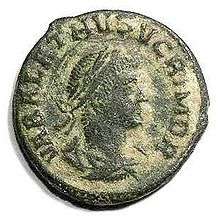Vaballathus
| Vaballathus | |
|---|---|
| King of kings and Emperor of Palmyra | |
 Antoninianus Struck by Aurelian. The coinage of Vabalathus also shows, at the beginning, portraits of Aurelian. This means that Aurelian and Vabalathus had recognized each other. | |
| King of kings, then emperor of Palmyra | |
| Reign | 267-272 |
| Predecessor | Maeonius |
| Successor |
Vacant Title next held by Antiochus |
| Father | Odaenathus |
| Mother | Zenobia |
Lucius Iulius (Julius) Aurelius Septimius Vabalathus Athenodorus (259-273) was a king of the Palmyrene Empire. Vabalathus is the Latinized form of his name in the Arabic language, Wahb Allat or gift of the Goddess. As the Arabian goddess Allāt came to be identified with Athena, he used Athenodorus as the Greek form of his name.
Life
His father was Septimius Odaenathus, King of Palmyra, and his mother was Queen Zenobia. When his father was assassinated by his cousin Maeonius (267), the young Vabalathus was made king (rex consul imperator dux Romanorum, "illustrious King of Kings" and corrector totius orientis) of the Palmyrene Empire. Effective power was wielded by his mother Zenobia, who conquered Lower Egypt, Syria (region), Palestine, Anatolia and Lebanon.
Initially the Roman Emperor Aurelian recognized Vabalathus' rule, perhaps because he was engaged in conflict with the Gallic Empire in the west and hesitated to incite open warfare with the Palmyrene Empire. This mutual recognition is testified by early coins minted under Vaballathus, in which Aurelian is portraited with the title augustus; however, the relationship between the two empires deteriorated and Aurelian disappeared from his coins, while Zenobia and Vabalathus have adopted the titles of Augusta and Augustus respectively.
The end of Vabalathus' rule came when Aurelian conquered and sacked Palmyra (272/3) and took Vabalathus and his mother back to Rome as hostages. According to Zosimus, Vaballathus died on the way to Rome, but this theory has been neither confirmed nor disproved.
Other sources have implied that after shipping the defeated Zenobia and Vabalathus back to Rome, Aurelian allowed both of the rebels to live, but only after they had been marched through the streets of the imperial city in accordance with Roman tradition. This would have been humiliating, but better than death. This theory is supported by Aurelian's similar treatment of the Tetricii (Tetricus I and Tetricus II) in Gaul, also allowing long time enemies of Rome to retire following their defeat at the Battle of Châlons in 274.
An excellent military tactician and a talented administrator, Aurelian was also one of the more merciful Roman Emperors in the empire's long history.
External links
| Wikimedia Commons has media related to Vabalathus. |
- Coinage of Vabalathus
- Long, Jacqueline F. "Vaballathus and Zenobia (270-272 A.D.)". De Imperatoribus Romanis.